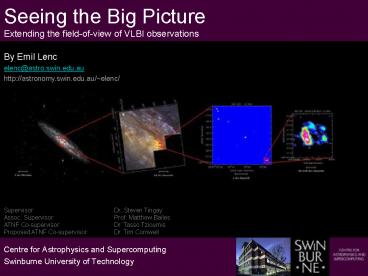Centre for Astrophysics and Supercomputing PowerPoint PPT Presentation
1 / 35
Title: Centre for Astrophysics and Supercomputing
1
Seeing the Big PictureExtending the
field-of-view of VLBI observations
By Emil Lenc elenc_at_astro.swin.edu.au http//astron
omy.swin.edu.au/elenc/
Supervisor Dr. Steven Tingay Assoc.
Supervisor Prof. Matthew Bailes ATNF
Co-supervisor Dr. Tasso Tzioumis Proposed ATNF
Co-supervisor Dr. Tim Cornwell
- Centre for Astrophysics and Supercomputing
- Swinburne University of Technology
2
Seeing the Big PictureExtending the
field-of-view of VLBI observations
- Why is VLBI required?
- Factors limiting the VLBI field-of-view and how
to overcome them. - Applications of wide-field VLBI and my current
findings. - Future work.
- Summary.
3
Why do we need VLBI?The Quest for Resolution
70 metres 1.5 arc-minute resolution (at 3cm /
10 GHz)
0.05 metres 3 arc-second resolution (at 600nm)
Just checking.
4
Why do we need VLBI?The Quest for Resolution
At 50 MHz, resolution is 1.5 degrees
At 600 MHz, resolution is 7 arc minutes
305 metres
At 10 GHz, resolution is 25 arc seconds
At visible wavelengths the human eye has
a resolution of about 20 arc seconds!
Arecibo Observatory, Puerto Rico.
5
The Bigger the Better?
gt 8 km !
Too Costly!
Green Bank November 15, 1988 Image courtesy of
NRAO/AUI
6
The Bigger the Better? Perhaps Not!
Technically "Challenging"!
Green Bank November 16, 1988 Image courtesy of
NRAO/AUI
7
The Long Baseline Array (LBA)
Baseline 1,700 km Resolution 10 mas
8
The Long Baseline Array (LBA)
Baseline 3,200 km Resolution 5 mas
9
Global VLBI
Baseline 12,000 km Resolution 1 mas
10
Space VLBI
Baseline 35,000 km Resolution 100 µas
11
VLBI Tunnel Vision
- VLBI field-of-view limited by
- Primary beam
- Bandwidth
- Time-averaging
- Non-coplanar effects
- Averaging of data leads to tunnel vision.
12
Limiting FactorsThe Primary Beam
The primary beam of a radio telescope defines the
ultimate limit of its field-of-view
Primary Beam FWHM (radians) 1.22 ? / D
Example 64m Parkes Telescope at 2.3GHz
has a FWHM of 8.5.
13
Limiting FactorsBandwidth Smearing
The extent of smearing depends on the parameter
v
A form of chromatic aberration. An effect which
in a similar guise affects optical telescopes.
(1 ?f / 2fo) (u2v2)1/2
(1 - ?f / 2fo) (u2v2)1/2
Synthesized beam size
u
Distance from phase centre
14
Limiting FactorsBandwidth Smearing
v
Smearing effects reduced with smaller bandwidth
channels.
u
Utilizing numerous smaller channels can increase
uv-coverage
given that the source does not vary greatly
across the band.
15
Limiting FactorsBandwidth Smearing
Example 566km LBA Observation at 2.3GHz, 16 MHz
bandwidth.
6.6 Field-of-view
0.5 MHz channels gt 210 Field-of-view
16
Limiting FactorsTime-Averaging Smearing
Time-Averaging smearing occurs because the
baseline vector rotates with the Earth during an
observation.
v
ta
Results in complex distortions and amplitude
reductions
u
Averaging time
Distance from phase centre
Synthesized beam size
17
Limiting FactorsTime-Averaging Smearing
Example 566km LBA Observation at 2.3GHz, 10s
averaging time.
1.3 field-of-view
2 second averaging gt 7.3 field-of-view
18
Limiting FactorsNon-coplanar Effects
ATCA is coplanar - 2D Fourier Transform can
recover sky brightness from uv data.
For non-coplanar arrays the 2D FT is only an
approximation for small fields-of-view.
Results in complex distortions and amplitude
reductions
Distance from phase centre
Image Credit Cornwell 2003
Synthesized beam size
19
Seeing the Bigger PictureOvercoming non-coplanar
effects
- Faceting
- Break the image into smaller fields each with a
different phase centre. - 3-D Fourier Transforms
- The non-coplanar problem is really a 3-D problem.
- Slow and very inefficient.
- W-Projection
- Projects w out of the problem and then use 2-D
FT. - An order of magnitude faster than faceting.
20
Limiting FactorsNon-coplanar Effects
Example 566km LBA Observation at 2.3GHz.
2 field-of-view.
With w-projection, limited only by the primary
beam size and level of bandwidth and
time-averaging smearing!
21
Applying Wide-field VLBI
Starbursts
Jets
Lenses
22
Applying Wide-field VLBIStarburst galaxies
- Supernovae
- Star formation history
- Free-free absorption
23
Applying Wide-field VLBIAGN jet interaction
- Resolve points of interaction.
- Constrain models for X-ray emission.
- Jet speed and kinetic power.
24
Applying Wide-field VLBIGravitational Lenses
- Study their structure and evolution.
- Constrain mass distribution of foreground object.
- Estimate expansion rate of the Universe.
25
Starburst Galaxies NGC 253
LBA (Parkes, ATCA, Mopra, Tidbinbilla)
Observation of NGC 253.
26
NGC 253Comparison with other radio observations
Xs mark sources detected by Ulvestad et al
(1997) at higher frequencies.
27
NGC 253 Free-Free Modelling Observed Sources
Xs mark sources detected by Ulvestad et al
(1997) at higher frequencies.
28
NGC 253A Null Detection Still Tells Us Something!
Xs mark sources detected by Ulvestad et al
(1997) at higher frequencies.
29
NGC 253Source 5.48-43.3
Radius of supernova 45 mas
Assuming free expansion of about 10,000 km/s this
suggests 5.48-43.3 went supernova approximately
53 years before this observation.
30
More Starbursts
Have applied for LBA time to observe more
starbursts at 1.4 GHz and 2.3 GHz
31
Jet Interactions Pictor A
Mystery
What's causing the residual side lobes?
32
Pictor A UV Coverage
33
Jet InteractionsAn AGN survey
Imaged 30 AGN at 1.4 GHZ and 2.5 GHz (selected
from Jones and McAdam, 1992).
Found 4 interesting AGN PKS B0344-345
PKS B0703-595 PKS B1308-441 PKS
B1637-771
34
Future Work
- On my way to observe NGC 4945, NGC 1313 and M83
at 2.3 GHz with the LBA AS I SPEAK! - Will observe PKS B0344-345 and two other AGN in
June with the ATCA at high resolution (22 GHz). - Have approval to observe NW hotspot of Pictor A
with the VLBA the highest ever spatial
resolution image of an AGN hotspot. - Stay tuned!
35
Summary
- VLBI can provide high resolution images but
unless careful only over small fields of view. - Wide-field VLBI can increase the field-of-view
from arc-seconds to arc-minutes. - Wide-field VLBI can be used to tell us more about
starburst galaxies, AGN jets and gravitational
lenses.

